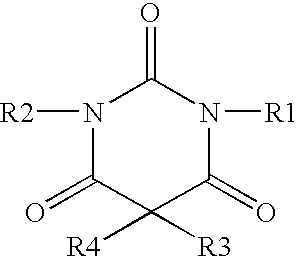Non-sedating barbiturate compounds as neuroprotective agents
a barbiturate and compound technology, applied in the field of non-sedating barbiturate compounds, can solve the problems of insufficient treatment, inability to achieve adequate therapy, and inability to reverse the damage of neurons and brain infarction, and achieve the effect of avoiding the toxicity and sedative effects of barbiturate, and without loss of efficiency
- Summary
- Abstract
- Description
- Claims
- Application Information
AI Technical Summary
Benefits of technology
Problems solved by technology
Method used
Image
Examples
example 1
General Design
[0048]The non-sedative barbiturate (NSB) drug is tested in rats exposed to either reversible or irreversible ischemia. Varying doses of drug are administered. The neuroprotective effect is compared to a negative control (placebo) and a positive control, pentobarbital, a known neuroprotective but sedative barbiturate, given at doses known to reduce infarct volume in cerebral ischemia (1-4).
[0049]Animals are sacrificed several days after the onset of the ischemic insult and the brains examined to determine the volume of brain infarction as an outcome measure of the drug's reduction of ischemic brain damage. The animals are examined clinically and graded prior to sacrifice to determine if the drug has conferred any beneficial effect on relevant functions following ischemic “stroke.”
[0050]Four experimental models are preferred for testing the neuroprotective effects of the NSB drug. See Ginsberg, M. D., “Animal Models of Global and Focal Cerebral Ischemia,” Chapter 34 in W...
example 2
Irreversible Cerebral Ischemia
[0059]Irreversible MCA occlusion was produced by ligating the carotid artery and then inserting a filament into the origin of the MCA with the animal maintained under halothane anesthesia. Blood flow in the MCA was measured by laser doppler and those animals in which a significant drop in blood flow occurred were considered to have experienced cerebral ischemia, and to be at risk for subsequent damage (i.e., a stroke). Indeed, no clinical strokes occurred in animals that did not experience a precipitous drop in MCA blood flow. All the animals showing with a drop in MCA blood flow experienced strokes.
[0060]Animals at risk were then followed behaviorally and scored by clinical findings using the Bederson grading scale as either:[0061]0 no evidence of stroke[0062]1 mild stroke[0063]2 moderate stroke[0064]3 severe stroke
[0065]Those animals that survived for three days were sacrificed and their brains examined. Animals to be sacrificed were given chloral hyd...
example 3
Reversible Cerebral Ischemia Model
[0075]Rats are pretreated as in Example 1 (above) and a similar procedure is performed except that the filament occluding the MCA is removed after 30 to 60 minutes, restoring blood flow through the MCA. Rats are then followed clinically for three days, graded for their degree of stroke and then sacrificed as in Example. The brains are removed and examined as described above.
[0076]The NSB compounds are shown to be neuroprotective under these conditions.
PUM
| Property | Measurement | Unit |
|---|---|---|
| concentrations | aaaaa | aaaaa |
| concentrations | aaaaa | aaaaa |
| concentrations | aaaaa | aaaaa |
Abstract
Description
Claims
Application Information
 Login to View More
Login to View More - R&D
- Intellectual Property
- Life Sciences
- Materials
- Tech Scout
- Unparalleled Data Quality
- Higher Quality Content
- 60% Fewer Hallucinations
Browse by: Latest US Patents, China's latest patents, Technical Efficacy Thesaurus, Application Domain, Technology Topic, Popular Technical Reports.
© 2025 PatSnap. All rights reserved.Legal|Privacy policy|Modern Slavery Act Transparency Statement|Sitemap|About US| Contact US: help@patsnap.com

